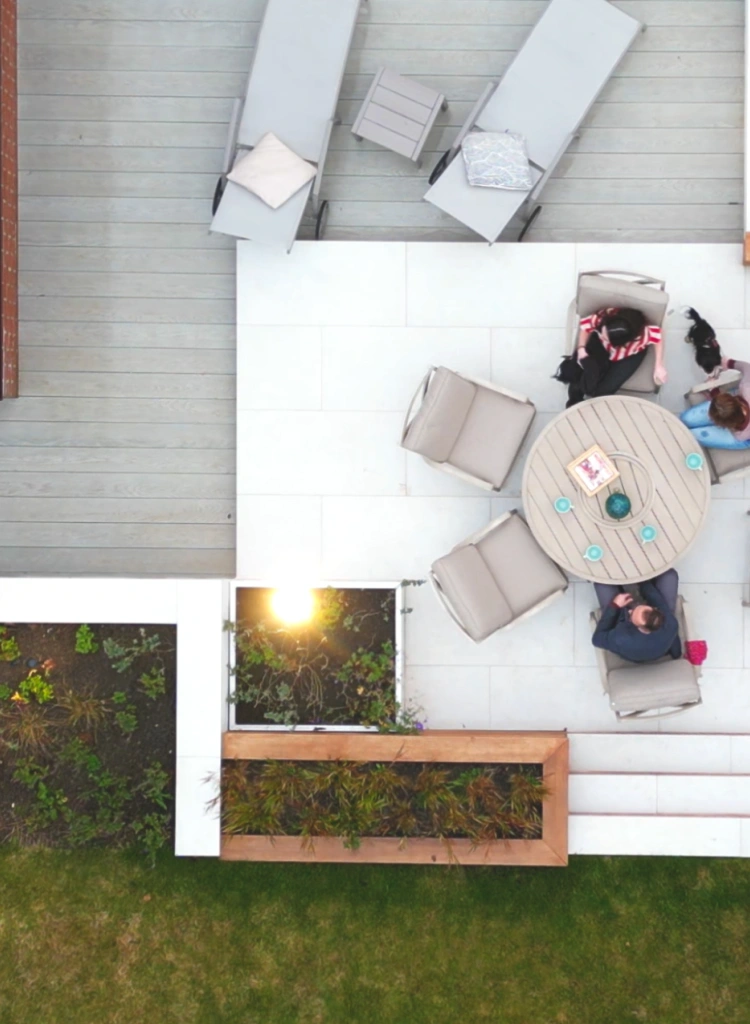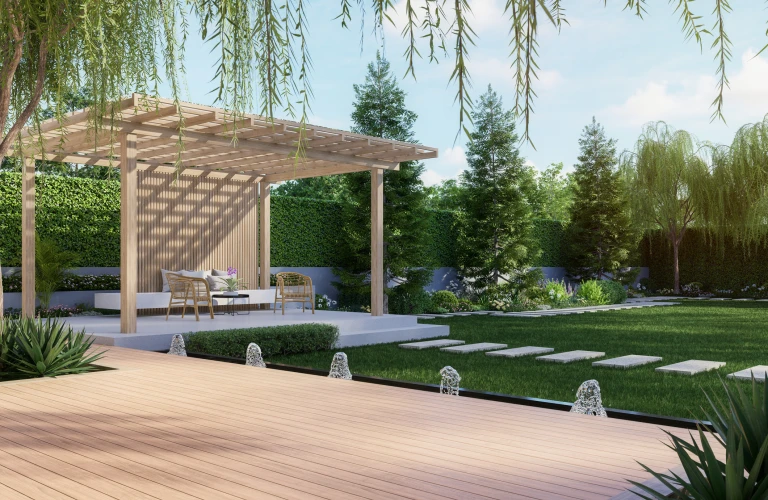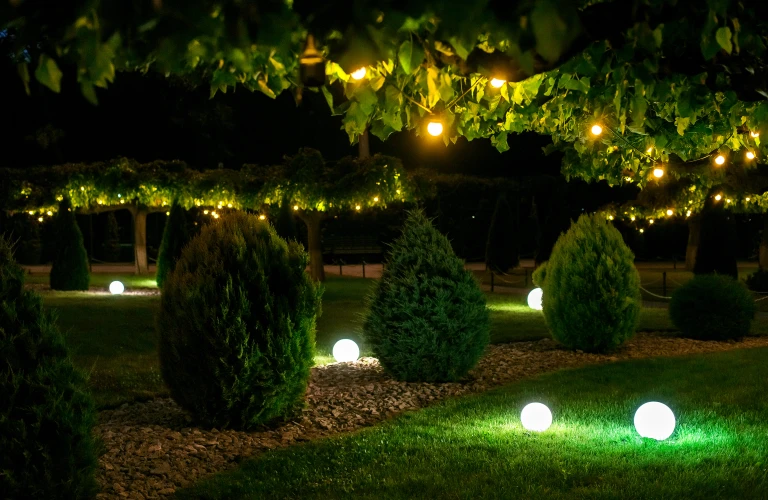
Average Cost of Landscaping a Garden UK 2023: Expert Tips
Garden hardscaping and planting can transform an outdoor space into a stunning oasis, but it’s important to understand the average cost of landscaping a garden in the UK, including flower beds and a new lawn, before embarking on such a project. The landscaping costs involved in soft landscaping and hard landscaping jobs can vary greatly depending on several factors, including the size of the garden, desired features, and complexity of the design.
Why is it crucial to have ideas of garden landscaping costs and money? Image credit. Well, knowing the average cost guide for garden design and maintenance garden projects allows you to set realistic expectations and plan your budget accordingly. Whether you’re looking to transform your garden space or add a beautiful garden pond, understanding the costs involved is essential. It helps you avoid any financial surprises along the way and ensures that you can create a beautiful garden without breaking the bank. Whether you’re considering soft landscaping or hard landscaping, it’s important to consider the landscaping cost and choose a reputable landscaping company.
In this blog post, we will delve into the various factors that influence landscaping expenses in the UK, including labour costs and the area of the garden. We will also provide insights into how understanding average costs of artificial grass can assist you in budgeting effectively for your dream garden. Additionally, we will share some creative ideas for your garden design.
Factors Affecting the Average Cost of Landscaping a Garden
There are several factors that can influence the overall garden landscaping costs. These factors include the area of the job and the ideas for the project. Understanding these ideas and factors in the area of labour cost will help you plan and budget accordingly for maintaining your grass. Let’s take a closer look at the key elements that determine the average cost of landscaping a garden area in the UK, including the grass and square metre.
Size and Complexity of the Garden
One of the major determinants of landscaping costs is the size and complexity of your garden area. The amount of grass that needs to be covered and the number of square metres that need to be landscaped will also impact the overall cost. Larger gardens generally require more materials, labor, and time to complete, which can drive up the overall cost of soft landscaping. The grass area in particular may require additional attention and resources. If your garden has intricate designs or unique features in the area that require specialized skills, such as complex paving patterns or intricate plant arrangements, this can also increase the cost.
Impact of Desired Features
The desired features you want to incorporate into your garden can significantly impact the labour cost in your area. If you envision having a patio or deck installed in your sloped garden, adding outdoor seating areas or entertaining spaces to your sloped garden will add to the overall cost. Similarly, if you have a sloped garden and desire water features like ponds or fountains, these additions will require additional materials, labour cost, and consideration of the area.
Influence of Soil Conditions and Terrain
The condition of your soil and terrain in a specific area can also affect landscaping expenses due to variations in labour cost. If your garden area has poor soil quality or requires extensive leveling or excavation work, this can increase both material and labor costs. Similarly, if your garden is located in an area with a slope or uneven ground, it may require additional measures such as retaining walls or terracing to create a level surface for landscaping purposes. These extra steps can increase the labour cost.
Consideration of Additional Elements
In addition to basic landscaping elements like plants and hardscaping features, other factors should be considered when estimating costs in the area. These additional elements include lighting systems for ambiance and security purposes in the area, as well as irrigation systems to ensure proper watering for plants in the area. While these components may add extra expenses upfront, they can enhance the functionality and aesthetics of your garden area in the long run.
Labour Costs
Labour costs in the area are a crucial factor when calculating the overall cost of landscaping a garden. Skilled professionals in the area, such as landscape architects or designers, may charge higher rates for their expertise and experience. The number of workers required in a specific area to complete the project within a specific timeframe can also impact costs.
Time
The time it takes to complete your landscaping project in the area can affect the final price. If you have strict deadlines or require expedited completion in your area, this may result in additional charges due to overtime or increased labor resources needed to meet your timeline.
Understanding Price Inclusions and Exclusions in Garden Landscaping
It’s important to understand the breakdown of costs involved. This will help you avoid any unexpected expenses and ensure that you have a clear understanding of what is included in the quotes you receive. Let’s dive into the details and discuss the differentiating factors between included services and extra charges.
Differentiating between included services and extra charges in quotes
When you receive a quote for garden landscaping, it’s essential to carefully review what is included and what may come with additional charges. The quote should clearly outline the services provided as well as any exclusions or optional extras. By understanding this distinction, you can make an informed decision about which elements are necessary for your project.
Commonly included items like labor, materials, and design fees
In most garden landscaping projects, certain items are typically included in the overall cost. These commonly include labor, materials, and design fees. Labor costs cover the physical work required to transform your garden, such as excavating, planting, paving, or constructing structures like pergolas or fences.
Materials play a significant role in determining the overall cost of landscaping your garden. This includes plants, trees, shrubs, soil amendments, mulch or gravel for pathways, decking materials if applicable, and any other necessary supplies. Design fees are also usually incorporated into the quote if you’re working with a professional landscape designer who will create a customized plan for your garden.
Additional costs for permits, waste removal or specialized equipment rentals
While some aspects of garden landscaping may be covered in the initial quote received from landscapers or contractors there are often additional costs that need to be considered. These can include permits required by local authorities for certain types of construction or modifications to your property.
Waste removal is another factor that may come with an extra charge. During the process of transforming your garden there will likely be a significant amount of debris and waste materials that need to be disposed of properly. This may involve hiring a skip or arranging for regular waste removal services.
In some cases, specialized equipment rentals may also be necessary. For example, if you have challenging terrain or require heavy machinery for specific tasks like tree removal or excavation, these costs may not be included in the initial quote.
Importance of clarifying what is covered to avoid unexpected expenses
To ensure that there are no surprisesIt’s crucial to clarify what is included in the quote provided by your chosen landscaper. By having open and transparent communication with them, you can gain clarity on any potential additional charges and discuss how they will be handled.
Be sure to ask questions about any items that are unclear or seem ambiguous in the quote. It’s better to address these concerns upfront rather than being caught off guard later on. By having a clear understanding of what is covered, you can budget accordingly and make informed decisions about which elements are essential for your garden transformation.
Budgeting for Garden Landscaping: How Much Should You Allocate?
Setting a realistic budget is a crucial step when planning your garden landscaping project. By carefully considering your specific needs and goals, you can ensure that you allocate an appropriate amount of funds to bring your vision to life. Here are some tips to help you budget effectively and avoid any financial surprises along the way.
Tips for setting a realistic budget based on your specific needs and goals
- Assess Your Needs: Take some time to evaluate what you want to achieve with your garden landscaping project. Are you looking to create a simple outdoor space for relaxation or do you have grand designs in mind? Understanding your needs will help determine the scale of the project and the associated costs.
- Prioritize Your Goals: Once you have identified your needs, prioritize them based on importance. This will allow you to allocate funds accordingly and focus on the key elements of your garden that matter most to you.
- Research Costs: It’s essential to research the average cost of landscaping projects in the UK to get an idea of what you should expect. This will give you a ballpark figure to work with when creating your budget.
- Consider Materials: The choice of materials can significantly impact the overall cost of your garden landscaping project. Different materials come with varying price tags, so be sure to factor this into your budget calculations.
- Factor in Labor Costs: Hiring professionals for certain aspects of your project, such as paving or installing irrigation systems, will incur labor costs. Be sure to include these expenses in your budget estimation.
Average percentage range homeowners allocate for garden landscaping projects
Homeowners typically set aside around 10% – 15%. However, it’s important to note that this range can vary depending on various factors such as location, property size, complexity of design, and personal preferences.
While this percentage range can serve as a general guideline, it’s crucial to remember that every project is unique. Some homeowners may choose to invest more in their gardens, while others may opt for a more modest budget. Ultimately, the decision should be based on your individual circumstances and what you are comfortable spending.
Considering long-term maintenance costs when planning your budget
When creating your garden landscaping budget, it’s essential to consider not only the initial installation costs but also the long-term maintenance expenses. Maintaining a well-landscaped garden requires ongoing care and attention, which may include tasks such as mowing, pruning, fertilizing, and watering.
To avoid unexpected financial burdens down the line, factor in these maintenance costs when planning your budget. It’s advisable to set aside an additional 10% – 20% of your overall project cost for annual upkeep and potential future renovations or repairs.
Researching prices from multiple landscapers to get an accurate estimate
To ensure you have an accurate estimate of the cost involved in your garden landscaping project, it’s wise to obtain quotes from multiple landscapers or contractors. This will allow you to compare prices and services offered by different professionals.
When soliciting quotes, provide each landscaper with a detailed description of your project requirements so that they can provide you with an accurate estimate. Remember to inquire about any additional charges or potential hidden costs that may arise during the course of the project.
By taking the time to research and gather quotes from various professionals, you can make an informed decision about which landscaper aligns best with your vision and budget constraints.
Hiring a Garden Designer vs. DIY: Pros and Cons
Benefits of Hiring a Professional Designer
Hiring a garden designer can bring numerous benefits to your landscaping project. These professionals have the expertise and creativity to transform your garden into a beautiful outdoor space. Here are some advantages of hiring a professional designer:
- Expertise: Garden designers have extensive knowledge and experience in horticulture, landscape design principles, and construction techniques. They understand how different plants grow, what works well together, and how to create functional and visually appealing layouts. By leveraging their expertise, you can ensure that your garden will thrive and look stunning.
- Creativity: Garden designers have an innate sense of creativity that allows them to envision unique designs tailored to your preferences and needs. They can take into account various factors such as the size of your garden, architectural style of your home, existing features, sunlight exposure, soil conditions, and more. With their creative touch, they can transform even the most ordinary spaces into extraordinary ones.
- Comprehensive Design Services: When you hire a garden designer, you gain access to their comprehensive range of design services. They will work closely with you to understand your vision for the garden and develop detailed plans encompassing layout designs, plant selections, material choices, lighting schemes, irrigation systems, and more. This ensures that every aspect of your garden is carefully considered for optimal results.
- Time-Saving: Landscaping projects require significant time investment in planning, sourcing materials, coordinating contractors (if needed), planting vegetation, and maintaining the overall project timeline. By hiring a professional designer who takes care of these tasks for you, you can save valuable time that can be spent on other priorities or simply enjoying your newly transformed garden.
Saving Money by Doing It Yourself
While hiring a professional designer has its merits, there are also advantages to taking on the landscaping project yourself:
- Cost Savings: One of the main reasons people choose to DIY their garden landscaping is to save money. By eliminating the cost of hiring a designer, you can allocate those funds towards purchasing plants, materials, and tools instead. You have the flexibility to source items at lower prices or repurpose existing elements in your garden.
- Personal Touch: When you take on the task of designing your garden yourself, you have complete control over every aspect. This allows you to infuse your personal style and preferences into the project, creating a space that truly reflects your taste and personality. It can be a rewarding experience to see your vision come to life through your own efforts.
- Learning Experience: Designing and landscaping your garden can be an opportunity for personal growth and learning new skills. You can explore different design principles, experiment with plant combinations, and develop practical knowledge about gardening techniques along the way. This newfound expertise can empower you to maintain and enhance your garden in the future.
- Flexibility: DIY projects offer flexibility in terms of timeline and execution. You can work at your own pace, taking breaks when needed or adjusting plans as you go along. This allows for greater adaptability based on budget constraints or unforeseen circumstances that may arise during the project.
While DIY landscaping offers cost savings and a hands-on approach, it’s important to consider whether you have the necessary time, skills, and resources to undertake such a project successfully.
Choosing the Right Landscaping Materials for Your Garden
Selecting the right materials is crucial. You want to create a beautiful and functional outdoor space that suits your style and budget. Here are some factors to consider when choosing the materials for your garden landscaping project.
Factors to Consider When Selecting Materials
Durability and aesthetics are two key factors to keep in mind when selecting materials for your garden. You want materials that can withstand the elements and last for years to come. Natural stone, such as granite or limestone, is a popular choice due to its durability and timeless appeal. Composite decking is another option that offers low maintenance and comes in a variety of colors and finishes. Artificial turf provides a lush green look without the need for mowing or watering.
Popular Options for Landscaping Materials
- Natural Stone: Natural stone adds elegance and charm to any garden design. It can be used for pathways, patios, or retaining walls.
- Composite Decking: Composite decking is a durable alternative to traditional wood decking. It requires less maintenance and is available in various styles.
- Artificial Turf: Artificial turf provides a hassle-free solution for those who want a green lawn all year round without the need for watering or mowing.
Comparing Prices Between Different Materials
Cost plays a significant role in any landscaping project, so it’s essential to compare prices between different materials before making a decision. Natural stone tends to be more expensive upfront but may require less maintenance over time compared to other options like composite decking or artificial turf.
Composite decking offers an affordable alternative to natural wood decking while still providing durability and aesthetic appeal. Artificial turf can be cost-effective in the long run since it eliminates the need for ongoing maintenance like watering or mowing.
Importance of Considering Maintenance Requirements
Maintenance requirements should also factor into your material selection process. Some materials may require regular cleaning, sealing, or upkeep, while others are relatively low maintenance. Natural stone may require occasional cleaning and resealing to maintain its appearance and durability. Composite decking typically requires periodic cleaning to remove dirt and debris. Artificial turf may need occasional brushing to keep the fibers upright.
Considering your available time and resources for maintenance is crucial when deciding on the right materials for your garden project.
Adding Value to Your Property with a Landscaped Garden
A well-designed garden can do wonders for your property value. Not only does it enhance the overall aesthetics of your home, but it also creates a welcoming and inviting atmosphere. Whether you’re planning to sell or rent out your property, investing in landscaping can significantly increase its appeal and attract potential buyers or tenants.
How a well-designed garden can increase property value
Statistics show that landscaping projects have a high return on investment (ROI). In fact, studies suggest that a beautifully landscaped garden can increase the value of your property by up to 20%. This means that if you invest £10,000 in landscaping, you could potentially add £20,000 to the overall value of your home. It’s important to keep in mind that these figures may vary depending on various factors such as location, size of the garden space, and the quality of the landscaping work.
Enhancing curb appeal and attracting potential buyers or tenants
First impressions matter. A well-maintained and aesthetically pleasing garden instantly catches the eye and creates a positive impression. Potential buyers or tenants are more likely to be drawn towards properties with beautiful gardens as they provide an instant sense of tranquility and relaxation.
By investing in professional landscaping services, you can transform your garden into an attractive outdoor space that stands out from neighboring properties. This can give you an edge over other sellers or landlords in the market and potentially lead to increased interest from potential buyers or tenants.
Creating functional outdoor spaces that add usable square footage
A landscaped garden not only adds visual appeal but also provides additional living space. With careful planning and design, you can create functional outdoor areas that serve as extensions of your indoor living spaces. These spaces can be used for entertaining guests, dining al fresco, or simply enjoying some quality time outdoors.
For example, adding a patio or deck allows you to create an outdoor seating area where you can relax and unwind. Installing a garden pond or water feature adds a touch of tranquility and can become a focal point in your garden. Incorporating features like vegetable beds or flower gardens can provide opportunities for gardening enthusiasts to indulge in their passion.
The benefits of professional landscaping
While some homeowners may choose to tackle their landscaping projects themselves, hiring a professional landscaper can offer numerous advantages. Here are some key reasons why seeking professional help is worth considering:
- Expertise: Professional landscapers have the knowledge and experience to design and execute landscaping projects that meet your specific needs and preferences.
- Time-saving: Landscaping requires careful planning, preparation, and execution. By hiring professionals, you can save valuable time and effort while ensuring high-quality results.
- Access to resources: Professional landscapers have access to a wide range of materials, plants, and equipment that may not be readily available to homeowners.
- Maintenance: A well-designed garden requires regular maintenance to keep it looking its best. Professional landscapers often offer ongoing maintenance services, ensuring that your garden remains in top condition.
Investing in professional landscaping not only adds value to your property but also saves you from the hassle of doing it all yourself. With their expertise and resources at hand, they can transform your garden into a beautiful outdoor space that enhances the overall appeal of your property.
Key Takeaways on the Average Cost of Landscaping a Garden in the UK
Congratulations! By reading through this blog post, you now have a solid understanding of the average cost of landscaping a garden in the UK. You’ve learned about the various factors that can affect the cost, such as size, complexity, and materials. You also know how to budget for your landscaping project and whether hiring a professional garden designer or opting for a DIY approach is right for you.
Now that you’re armed with this knowledge, it’s time to take action and turn your garden dreams into reality. Start by assessing your budget and determining how much you’re willing to allocate for your landscaping project. Consider reaching out to local landscapers or designers who can provide quotes tailored to your specific needs. Remember, investing in a beautifully landscaped garden not only enhances your property’s value but also creates an oasis of tranquility where you can relax and unwind.
FAQs
How long does it typically take to complete a garden landscaping project?
The duration of a garden landscaping project depends on various factors such as the size and complexity of the design, weather conditions, availability of materials, and the contractor’s schedule. While some projects can be completed within weeks, others may take several months. It’s best to consult with your chosen landscaper or designer to get an estimated timeline based on your specific requirements.
Can I save money by doing my own garden landscaping?
Yes, opting for a DIY approach can help save money on labor costs. However, keep in mind that landscaping requires expertise in design principles, horticulture knowledge, and proper implementation techniques. If you have experience or are willing to invest time in learning these skills, DIY could be a viable option. Otherwise, it’s advisable to hire professionals who can ensure quality results.
What are some low-maintenance options for garden landscaping?
If you prefer minimal upkeep for your garden landscape, consider incorporating low-maintenance elements such as native plants, mulch beds, and automated irrigation systems. These choices can reduce the need for constant watering, weeding, and pruning while still providing an attractive outdoor space.
How can I find a reliable garden landscaper in my area?
To find a reputable garden landscaper in your area, start by asking for recommendations from friends, family, or neighbors who have recently had landscaping work done. You can also check online directories or review platforms to read feedback from previous clients. When selecting a landscaper, make sure to ask for references and view their portfolio to ensure they have the expertise and style that aligns with your vision.
Are there any regulations or permits required for garden landscaping projects?
The need for permits or adherence to regulations may vary depending on your location and the scope of your project. It’s important to research local building codes and consult with your landscaper or local authorities to determine if any permits are necessary. This step will help you avoid potential legal issues and ensure that your project is compliant with all relevant regulations.
Other Posts

Native Planting Schemes for Glasgow Gardens

